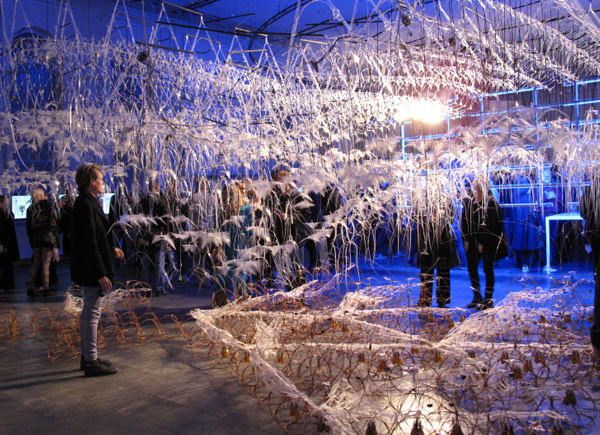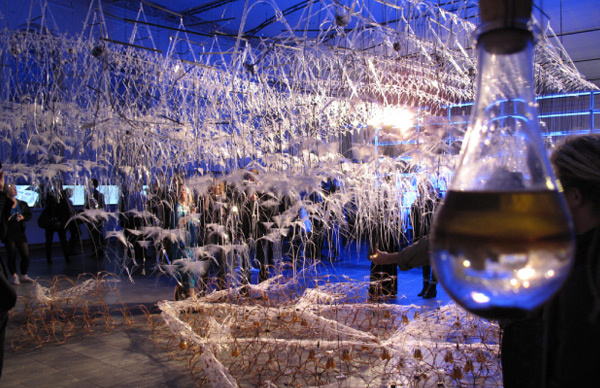Philip Beesley Summer School (2009)

An international summer school with CITA and Philip Beesley and University of Waterloo.
The summer school investigated how concepts of interactivity and responsiveness can suggest new ways of thinking the relationship between the building and its environment. The contemporary societal context necessitates the thinking of sustainable solutions for our built environment. But how do these challenge the way we think and design space? How do we challenge our understanding of sustainability from being a set of posterior technological implementations to become part of the intellectual thinking and culture of architecture? Where formalist design traditions uphold the autonomy of the architectural artefact, we ask how ideas of interfacing and actuated behaviour can allow a re-conceptualisation of core architectural terms such as context, shelter, programme and extension.
The summer school took place at CITA on August 10 – 24, 2009 and had a wide international participation of students and other interested parties from KARCH, Waterloo and beyond.
More information can be found on the related blog http://responsiveenvironments.wordpress.com/ .

Questions
The summer school asks: 1) If interactivity presents us with an inherent openness towards the exterior, how can new models of permeability and exchange challenge the way we think site and enclosure? 2) If embedded actuation allows for adaptable structures, how does this challenge the primacy of permanence in architectural design? 3) What are the technologies and materials that can enable the realisation of this new architecture of responsiveness: what is energy, how can we harvest it and how do we exploit it?

Goal
The goal of the summer school was to develop a major interactive architectural environment. The installation was developed at the Centre for Information Technology and Architecture (CITA), Royal Academy of Fine Arts, at the Royal Danish Academy during August 2009, involving an intensive two week workshop that brought together students and faculty from Waterloo, The Royal Academy of Fine Arts, School of Architecture, Philadelphia's PennDesign, and other European schools to work closely with experimental architectural designers and creators within the Copenhagen community at CITA.
The workshop designed and fabricated a new immersive kinetic sculpture environment that responds to user stimulus with dense, distributed fields of physical movement controlled by massively repeated arrays of microcomputers embedded within the textile-like layers of the space. This will be mounted in a large public gallery space on the grounds of the Royal Danish Academy.
By working collaboratively to produce and refine this installation, the participants gained advanced experience in key aspects of responsive architectures: networks and systems composed of complex parts assembled into coherent artificial 'organisms', actuation systems based on shape memory alloys, innovative techniques for creating large volumes out of small amounts of material, implementation of digital fabrication and advanced modeling, simulation and visualization techniques.

Description
Working in collaboration with Philip Beesley (Waterloo) and Mette Ramsgard Thomsen (director CITA), a group of 16 students were trained in experimental methods of digital fabrication, lightweight component design, accretive geometry, interactive systems including electronics, kinetics, controls and behaviour scripting.

An initial workshop and installation provided skill-building and hands on experience in the systems that will be used throughout the course. Individual and group development preceded permitting specialized exploration weighted to participant interests. The workshop culminated in an immersive installation exhibited in the gallery spaces of the Royal Danish Academy and the exhibit was refined and remounted in a major gallery space created for the United Nations Climate Change Conference in Copenhagen, December 7-18, 2009.

Sargasso Fields
The program integrated and optimized durable kinetic mechanisms with control systems characterized by decentralized responsive intelligence, using massively repeating miniaturized custom laser-cut components, low-cost custom microprocessors, sensors and actuators. The work was developed by means of exchanges between Beesley, Thomsen, expert collaborators and the participants, each focusing on specialized layers that are brought together in cycles of development.

Collaborators
CITA (Mette Ramsgard Thomsen, Martin Tamke, Phil Ayres, Anders Holden Deleuran)
Philip Beesley Architects (Philip Beesley, Hayley Isaacs, Jonathan Gammell)
AD:MT Aalborg University (Esben Skouboe Poulsen)
Along with students and staff from the Royal Danish Academy of Fine Arts, School of Architecture in Copenhagen and University of Waterloo, Ontario, Canada. Beyond these, individuals from practice and other faculties from around the globe joined the project.



